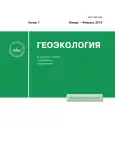Forty-year evolution of radioactive groundwater contamination at the site of radioactive waste storage (St. Petersburg region, Russian Federation)
- 作者: Rumynin V.G.1,2, Zamaskin D.N.3, Vladimirov K.V.1, Plotnikov A.V.3, Lelyavin I.A.3, Nikulenkov A.M.1,2, Kaplan E.M.1,2, Khodina V.A.1
-
隶属关系:
- St.Petersburg Division, Sergeev Institute of Environmental Geoscience, Russian Academy of Sciences
- Institute of Earth Sciences, St. Petersburg State University
- RosRAO Federal State Unitary Enterprise, Northwest region, Leningrad division
- 期: 编号 1 (2019)
- 页面: 3-16
- 栏目: Articles
- URL: https://journals.eco-vector.com/0869-7809/article/view/11810
- DOI: https://doi.org/10.31857/S0869-7809201913-16
- ID: 11810
如何引用文章
详细
Evolution of tritium and beta contamination plumes resulted from radioactive waste leakage in the 1990s has been studied based on 40-year-long monitoring data at the site of radioactive waste (RW) storage. Localand regional-scale hydrodynamics are found to be the main features controlling the spreading of tritium contamination in the aquifer system, while spatial distribution of beta-activity plume is strongly restricted by sorption of 90Sr и 137Cs isotopes onto rock matrix. The study performed proves that groundwater system at the site is actually in the stage of rehabilitation from the «historical» contamination. Special complex investigation program aimed on examination of water accumulated in repository buildings and its interconnection with groundwater, demonstrated good isolation of the buildings from the surrounding aquifers and no evidence of RW release to the subsurface environment nowadays.
全文:
作者简介
V. Rumynin
St.Petersburg Division, Sergeev Institute of Environmental Geoscience, Russian Academy of Sciences; Institute of Earth Sciences, St. Petersburg State University
编辑信件的主要联系方式.
Email: office@hgepro.ru
俄罗斯联邦, Srednii pr. 41, St. Petersburg, 199004; Universitetskaya nab. 7-9, St. Petersburg, 199004
D. Zamaskin
RosRAO Federal State Unitary Enterprise, Northwest region, Leningrad division
Email: len.szto@rosrao.ru
俄罗斯联邦, Sosnovy Bor, Industrial zone, P.O. Box 5, Leningrad oblast, 188540
K. Vladimirov
St.Petersburg Division, Sergeev Institute of Environmental Geoscience, Russian Academy of Sciences
Email: office@hgepro.ru
俄罗斯联邦, Srednii pr. 41, St. Petersburg, 199004
A. Plotnikov
RosRAO Federal State Unitary Enterprise, Northwest region, Leningrad division
Email: len.szto@rosrao.ru
俄罗斯联邦, Sosnovy Bor, Industrial zone, P.O. Box 5, Leningrad oblast, 188540
I. Lelyavin
RosRAO Federal State Unitary Enterprise, Northwest region, Leningrad division
Email: len.szto@rosrao.ru
俄罗斯联邦, Sosnovy Bor, Industrial zone, P.O. Box 5, Leningrad oblast, 188540
A. Nikulenkov
St.Petersburg Division, Sergeev Institute of Environmental Geoscience, Russian Academy of Sciences; Institute of Earth Sciences, St. Petersburg State University
Email: office@hgepro.ru
俄罗斯联邦, Srednii pr. 41, St. Petersburg, 199004; Universitetskaya nab. 7-9, St. Petersburg, 199004
E. Kaplan
St.Petersburg Division, Sergeev Institute of Environmental Geoscience, Russian Academy of Sciences; Institute of Earth Sciences, St. Petersburg State University
Email: office@hgepro.ru
俄罗斯联邦, Srednii pr. 41, St. Petersburg, 199004; Universitetskaya nab. 7-9, St. Petersburg, 199004
V. Khodina
St.Petersburg Division, Sergeev Institute of Environmental Geoscience, Russian Academy of Sciences
Email: office@hgepro.ru
俄罗斯联邦, Srednii pr. 41, St. Petersburg, 199004
参考
- Rumynin, V.G., Pankina, E.B., Yakushev, M.F., Boronina, A.V., Kuznetsova. E.L., Kukushkina, T.A., Kharkhordin, I.L., Potapov, A.A. , Tokarev, I.V., Konosavsky, P.K., Abramov, V.Yu., Epimakhov, V.N., Pereverzeva, S.A., Kharkovsky, K.S. Otsenka vliyaniya atomno-promyshlennogo kompleksa na podzemnye vody i smezhnye prirodnye ob’ekty (g. Sosnovyi Bor Leningradskoi oblasti) [Assessment of the influence of the atomic-industrial complex on groundwater and adjacent natural bodies (Sosnovy Bor, Leningrad oblast)]. St.Petersburg, St.Petersburg St. Univ. Publ., 2002, 249 p. (in Russian)
- Rumynin, V.G. Geomigratsionnye modeli v gidrogeologii [Geomigration models in hydrogeology]. St.Petersburg, Nauka Publ., 2011. 1158 p. (in Russian)
- Rumynin, V.G., Kaplan, E.M., Schwartz, A.A., Nikulenkov, A.M., Pankina, E.B., Glukhova, M.P., Luneva, E.V. Monitoring podzemnykh vod v zone vliyaniya stroyashcheisya LAES-2: metodicheskie aspekty i rezul’taty [Groundwater monitoring in the zone of influence of LNPP-2 under construction: methodological aspects and results]. Ecology and Atomic Energy, 2015, no. 2, pp. 124–134. (in Russian)
- Speshilov, S.L., Barinov, A.S., Lobanov, N.F., Tkachenko, A.V., Sitnikov, S.A., Cherkesov, A.E. Predvaritel’nyematerialy po otsenke vozdeistviya na okruzhayushchuyu sredu. Punkt zakhoroneniya radioaktivnykh otkhodov nizkogo i srednego urovnya aktivnosti v raione raspolozheniya Leningradskogo otdeleniya filiala «Severo-Zapadnogo territorial’nogo okruga FGUP «RosRAO» [Preliminary materials on environmental impact assessment. Burial site for low and medium level radioactive waste in the area of the Leningrad division of the Northwest region of FSUE “RosRAO”]. Moscow, FSUE “NO RAO”,2013. 220 p. (in Russian)
- Rumynin, V.G. Subsurface solute transport models and case histories with application to radionuclide migration. Springer, 2011. 860 p.
- Rumynin, V.G., Nikulenkov, A.M. Geological and physicochemical controls of the spatial distribution of partition coefficients for radionuclides (Sr-90, Cs-137, Co-60, Pu-239,240 and Am-241) at a site of nuclear reactors and radioactive waste disposal (St. Petersburg region, Russian Federation). Journal of Environmental Radioactivity [Internet]. Elsevier BV; 2016 Oct; 162–163:205–18. Available at: http://dx. doi.org/10.1016/j.jenvrad.2016.05.030.
补充文件









